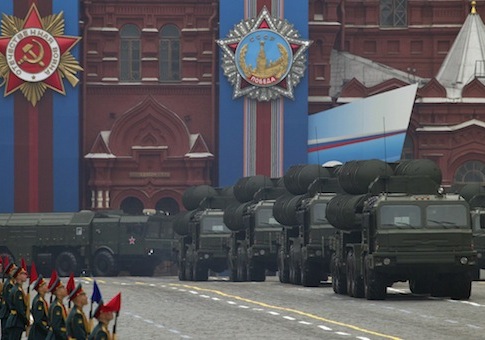Russian nuclear forces conducted a major exercise last month that tested the transport of both strategic and tactical nuclear weapons near Europe, according to United States officials.
The exercise raised concerns inside the Pentagon and with the U.S. European Command because it was the largest exercise of its kind in 20 years and involved heightened alert status of Russian nuclear forces.
The nuclear drills were part of other military maneuvers in Russia carried out between Feb. 17 and Feb. 21.
The exercises followed a recent surge in Russian strategic bomber flights that include a recent circling of the U.S. Pacific island of Guam by two Tu-95 Bear bomber and simulated bombing runs by Tu-95s against Alaska and California in June and July.
Pentagon spokesman Lt. Col. Wesley P. Miller sought to play down the nuclear exercise but declined to comment on the movement of nuclear weapons and whether nuclear forces went on a heightened state of alert. "We don’t comment on intelligence matters," he said.
Miller said the nuclear forces maneuvers were "nothing to be concerned about because the Russians, like us, have routine exercises and inspections."
However, a U.S. official said the exercise was a concern within the U.S. national security community because of the scale of the exercise and the number of weapons being moved. "Certainly it’s a concern when you have this kind of exercise going on," this official said.
The official said another worry is that Russia appears to be increasing the readiness of its nuclear forces at a time when the U.S. nuclear complex is in urgent need of upgrading and the military is facing sharp automatic defense cuts that could affect U.S. nuclear forces readiness in the future.
Contractors and employees of the National Nuclear Security Administration, which runs the nuclear weapons complex, were notified of possible furloughs under automatic spending cuts that went into effect March 1, the Hill reported Thursday.
Miller said the administration remains committed to a safe, secure, and effective nuclear deterrent. "The administration will ensure continued focus on maintaining a strong nuclear deterrent as part of the president's comprehensive approach to nuclear security," under sequester, as the automatic spending cuts are called.
He quoted past Defense Secretary Leon Panetta as saying that no decisions on how cuts will be made but that "nothing will be off the table in our review of how best to proceed."
According to the officials, the exercise involved Russia’s secretive 12th Main Directorate of the Defense Ministry, known by its acronym as 12th GUMO, the main military unit in charge of all nuclear weapons.
Details of the nuclear exercise are classified, but officials said the 12th GUMO transported a large number of nuclear arms from some of its nuclear munitions depots to storage sites during the exercises.
It could not be learned if the Russians provided advance notification of the strategic exercises.
Declassified U.S. intelligence reports have identified three large nuclear storage facilities near Europe, including one that is located miles from the intersection of the Rusisan, Latvian, and Belarusian borders. Two other nuclear storage complexes close to Europe are located at Zhukovka, near Belarus, and at Golovchino, near the Ukrainian city of Kharkiv.
The nuclear training coincided with the visit to Moscow by Rose Gottemoeller, acting undersecretary of state for arms control and international security, to discuss a new round of U.S.-Russian strategic arms talks.
The exercise did not come up during the meeting between Secretary of State John Kerry and Russian Foreign Minister Sergei Lavrov in Berlin Feb. 26.
Arms control experts say the Russians are required to notify the United States under the New START treaty of major strategic nuclear exercises that involve bomber flights.
It is not known whether the nuclear weapons were transported by air, rail, or truck during the 12th GUMO exercise.
Chief of the Russian General Staff Gen. Valery Gerasimov mentioned the nuclear exercise Feb. 22 when he said a surprise inspection of both conventional and nuclear forces was held.
Gerasimov said the exercises involved the 12th GUMO and the Central and Southern military districts and that they were the largest maneuvers of its kind in 20 years.
The drills began with orders for forces to go to "higher states of combat readiness and carry out combat training missions," the website Russian Defense Policy reported. The exercises were also reported by the Voice of Russia and the Russian Defense Ministry website.
Several hundred pieces of equipment, 7,000 troops, and 48 aircraft took part, the general said.
The drills also involved moving forces to exercise areas far from normal deployment locations.
Gerasimov said the 98th Air-Assault Division at Ivanovo and the 4th Air Forces and Air Defense Command near Rostov performed well.
The troops were transported in IL-76 jets to an area near Chelyabinsk, which has large nuclear facilities, in difficult weather conditions.
Forces of a long-range aviation group and air defense also conducted bombing exercises and performed well, Gerasimov said.
The general did not say how the 12th GUMO fared in the exercises but said that overall "a number of systematic deficiencies in the state of combat readiness and lever of personnel training" were uncovered.
A 2008 State Department cable described the 12th GUMO as one of several key military units with direct control over nuclear weapons. "An attack or exploitation of any one of these could leave elements of the arsenal vulnerable," the cable said. "While the impact on the U.S. might not be immediate, the danger of such elements falling into terrorists' or extremists' hands could pose a serious threat to the national security of the United States."
Another cable said nine 12th GUMO sites were being modernized in 2008.
